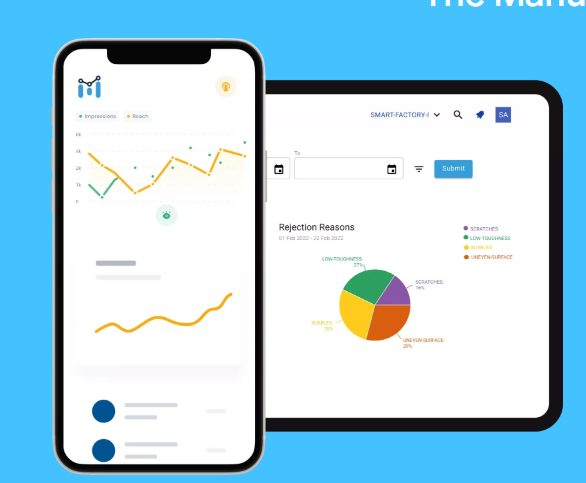Material Requirement Planning (MRP)
Material Requirement Planning (MRP) is a systematic approach to calculate the materials and components needed to manufacture a product. It ensures that materials are available for production and products are available for delivery to customers. MRP involves three primary steps: inventory management, bill of materials processing, and scheduling. It relies on data such as production schedules, inventory levels, and lead times. By analyzing these inputs, MRP helps manufacturers maintain optimal inventory levels, reduce waste, and improve production efficiency.
Manufacturing Execution System (MES)
A Manufacturing Execution System (MES) is a dynamic information system that monitors, tracks, documents, and controls the entire production process on the factory floor. The MES provides real-time data and insights, allowing manufacturers to manage and optimize production activities efficiently. Key functionalities of MES include work order management, resource allocation, scheduling, production tracking, and performance analysis. By integrating with other enterprise systems such as ERP (Enterprise Resource Planning), MES enhances visibility and coordination across the manufacturing operation, leading to improved product quality, compliance, and operational efficiency.
Manufacturing Information System (MIS)
Manufacturing Information System (MIS) refers to the integrated framework of information systems used to manage the manufacturing operations within an organization. MIS includes various subsystems such as ERP, MES, SCADA (Supervisory Control and Data Acquisition), and QMS (Quality Management System). The primary goal of MIS is to streamline data flow across different departments, improve decision-making, and enhance overall productivity. By providing accurate and timely information, MIS helps manufacturers respond swiftly to market changes, manage supply chains effectively, and maintain high standards of product quality.
Manufacturing Operations Management (MOM)
Manufacturing Operations Management (MOM) encompasses all activities involved in managing the manufacturing process, from raw material acquisition to finished product delivery. MOM integrates various functions such as production planning, scheduling, quality control, maintenance, and logistics. The objective of MOM is to optimize production processes, reduce costs, and improve product quality. By leveraging advanced technologies like IoT (Internet of Things), AI (Artificial Intelligence), and big data analytics, MOM enables manufacturers to achieve greater efficiency, flexibility, and agility in their operations.
Production System in Production Management
The production system in production management refers to the organized set of processes and activities involved in transforming raw materials into finished products. It includes the design, operation, control, and optimization of production processes. Key components of a production system include inputs (materials, labor, energy), processes (manufacturing operations), and outputs (finished goods). Effective production management ensures that the production system operates efficiently, meets quality standards, and delivers products on time. Techniques such as Lean manufacturing, Six Sigma, and Total Quality Management (TQM) are often employed to enhance the performance of the production system.
Production Management System (PMS)
A Production Management System (PMS) is a comprehensive framework used to plan, monitor, and control all aspects of the production process. PMS integrates various functions such as inventory management, production scheduling, quality control, and resource allocation. By providing real-time data and analytics, PMS helps managers make informed decisions, optimize resource utilization, and improve production efficiency. The implementation of a robust PMS can lead to significant cost savings, higher product quality, and faster time-to-market.
Production Operations Management (POM)
Production Operations Management (POM) involves the planning, organizing, and supervising of production processes to ensure efficient use of resources and timely delivery of products. POM covers a broad range of activities including process design, production planning, capacity management, quality assurance, and maintenance. The goal of POM is to maximize productivity, minimize costs, and ensure the consistent quality of products. By adopting best practices and innovative technologies, production operations managers can enhance operational efficiency and competitiveness.
Production and Operation Management (POM)
Production and Operation Management (POM) is a multidisciplinary field that focuses on the efficient and effective management of production and operations within an organization. It combines principles of engineering, management, and information technology to optimize production processes and supply chain activities. POM encompasses various aspects such as product design, process optimization, supply chain management, quality control, and logistics. The objective is to deliver high-quality products at the lowest possible cost while meeting customer demands. By implementing strategic POM practices, organizations can achieve operational excellence and sustain competitive advantage in the marketplace.
Visit here: https://manufapp.com/



